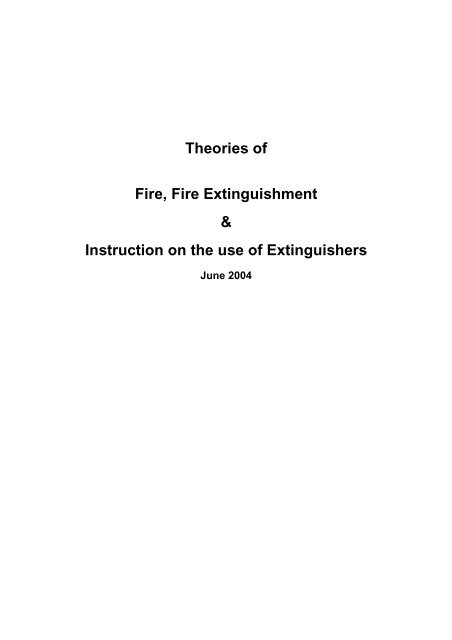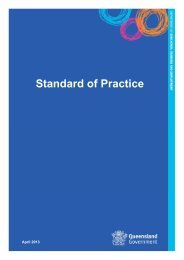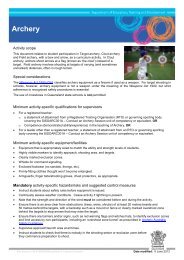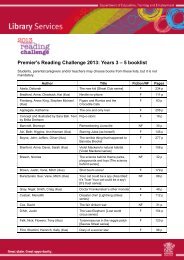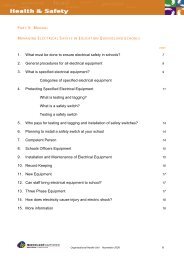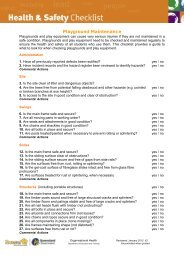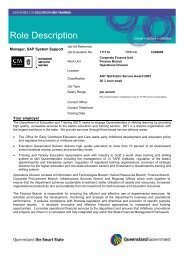Theories of Fire, Fire Extinguishment & Instruction of the use of ...
Theories of Fire, Fire Extinguishment & Instruction of the use of ...
Theories of Fire, Fire Extinguishment & Instruction of the use of ...
Create successful ePaper yourself
Turn your PDF publications into a flip-book with our unique Google optimized e-Paper software.
<strong>Theories</strong> <strong>of</strong><br />
<strong>Fire</strong>, <strong>Fire</strong> <strong>Extinguishment</strong><br />
&<br />
<strong>Instruction</strong> on <strong>the</strong> <strong>use</strong> <strong>of</strong> Extinguishers<br />
June 2004
Upon discovery <strong>of</strong> <strong>Fire</strong> or Smoke<br />
R.A.C.E.<br />
1. Remove persons from immediate danger!<br />
2. Alert o<strong>the</strong>rs in near vicinity and Administration<br />
3. Contain <strong>Fire</strong> and Smoke (close doors)<br />
4. Evacuate and/or Extinguish<br />
WHAT IS FIRE?<br />
<strong>Fire</strong> is a chemical reaction in which oxygen is combined with a gaseous or vaporous fuel.<br />
Note that, even if <strong>the</strong> fuel is a solid (e.g. wood) or a liquid (e.g. petrol) it is <strong>the</strong> vapours given<br />
<strong>of</strong>f when <strong>the</strong> fuel is heated that burn. This rapid oxidation produces heat and light (flames).<br />
<strong>Fire</strong> can usually take place only when <strong>the</strong>se three elements are present:<br />
• Oxygen<br />
• Fuel<br />
• Heat (energy)<br />
These 3 elements make up what is commonly called <strong>the</strong> '<strong>Fire</strong> Triangle.'<br />
Oxygen:<br />
Fuel:<br />
Heat:<br />
• Oxygen is usually readily available. It makes up 21% <strong>of</strong> <strong>the</strong> air we brea<strong>the</strong>.<br />
• solid combustibles like paper, furniture, clothing and plastics<br />
• flammable liquids like petrol, oils, kerosene, paints, solvents and cooking oils / fats<br />
• flammable gases like natural gas, LPG, acetylene<br />
• The heat given <strong>of</strong>f by <strong>the</strong> oxidation reaction sustains <strong>the</strong> fire once it is established. But first, a<br />
heat source is required to produce ignition<br />
Ignition sources include:<br />
• heating and cooking appliances<br />
• faulty electrical equipment<br />
• cigarettes, lighters and matches<br />
• friction
Chemical Chain Reaction:<br />
Research has added a fourth side to <strong>the</strong> fire triangle concept resulting in <strong>the</strong> development<br />
<strong>of</strong> a new model called <strong>the</strong> '<strong>Fire</strong> Tetrahedron.'<br />
The fourth element involved in <strong>the</strong> combustion process is referred to as <strong>the</strong> 'chemical chain<br />
reaction'. Specific chemical chain reactions between fuel and oxygen molecules are<br />
essential to sustain a fire once it has begun.
FIRE EXTINGUISHMENT<br />
Essentially, fires are extinguished by taking away one or more <strong>of</strong> <strong>the</strong> elements in <strong>the</strong> fire<br />
tetrahedron.<br />
This can be achieved by:<br />
• Removal or separation <strong>of</strong> unburnt FUEL (eg turn <strong>of</strong>f <strong>the</strong> gas)<br />
• Removal or dilution <strong>of</strong> <strong>the</strong> OXYGEN supply (eg smo<strong>the</strong>ring <strong>the</strong> fire with a fire blanket or an<br />
inert gas)<br />
• Removal <strong>of</strong> <strong>the</strong> HEAT <strong>of</strong> <strong>the</strong> oxidation reaction (eg spraying <strong>the</strong> fuel with water)<br />
• Inhibiting <strong>the</strong> CHAIN REACTION by modifying <strong>the</strong> combustion chemistry<br />
Sound fire prevention practices are based upon <strong>the</strong> principle <strong>of</strong> keeping fuel and ignition<br />
sources apart.<br />
CLASSES OF FIRE<br />
<strong>Fire</strong>s are classified according to <strong>the</strong> type <strong>of</strong> fuel involved. Not all extinguishing agents are<br />
compatible with all types <strong>of</strong> fuel (eg water <strong>use</strong>d on a flammable liquid fire is likely to increase<br />
<strong>the</strong> rate <strong>of</strong> burning dramatically and to disperse <strong>the</strong> fuel to cover a greater area).<br />
Thus, if <strong>the</strong> wrong type <strong>of</strong> extinguisher is selected <strong>the</strong> fire situation can be made worse, <strong>of</strong>ten<br />
threatening your own personal safety. Some extinguishers are simply more effective than<br />
o<strong>the</strong>rs on particular classes <strong>of</strong> fire.<br />
The various types <strong>of</strong> fires are classified as follows:<br />
Class A <strong>Fire</strong>s involving carbonaceous solids, such as wood, cloth,<br />
paper, rubber and plastics. Class A does not include flammable<br />
metals (see Class D).<br />
Class B <strong>Fire</strong>s involving flammable and combustible liquids.<br />
Class C <strong>Fire</strong>s involving combustible gases.<br />
Class D <strong>Fire</strong>s involving certain combustible metals, including<br />
potassium, sodium, & magnesium. Specialist advice should be<br />
sought.<br />
Class E Electrical Hazards<br />
Class F <strong>Fire</strong>s involving cooking oils and fats.<br />
Most fire extinguishers have a pictograph label identifying <strong>the</strong> type <strong>of</strong> fuels that may be<br />
extinguished.<br />
Electrical hazards<br />
Where a fire, involving an electrical hazard, can be expected, <strong>the</strong> extinguisher must be<br />
electrically non-conductive, in addition to having <strong>the</strong> correct classification for <strong>the</strong> materials<br />
involved. The marking <strong>of</strong> '(E)' on <strong>the</strong> fire extinguisher indicates <strong>the</strong> extinguisher is safe for<br />
extinguishing a fire involving energised electrical equipment.
FIRE SAFETY INFORMATION<br />
FIRE EXTINGUISHERS<br />
Portable fire extinguishers are designed to attack a fire in its initial stage. The selection <strong>of</strong> a<br />
suitable extinguisher is primarily influenced by <strong>the</strong> following factors:<br />
• <strong>the</strong> size and rate <strong>of</strong> fire spread<br />
• <strong>the</strong> Class <strong>of</strong> fire (i.e. type <strong>of</strong> materials involved)<br />
• <strong>the</strong> training and capabilities <strong>of</strong> <strong>the</strong> person using <strong>the</strong> extinguisher<br />
Note: Always follow <strong>the</strong> specific instructions on a fire extinguisher and familiarise yourself with<br />
<strong>the</strong>se instructions prior to an emergency situation. Persons should be trained in <strong>the</strong> <strong>use</strong> <strong>of</strong><br />
extinguishers to optimise <strong>the</strong>ir effectiveness.<br />
General Guidelines for Using a <strong>Fire</strong> Extinguisher<br />
P.A.S.S.<br />
1. raise <strong>the</strong> alarm, summon help and have someone call <strong>the</strong> fire service on '000'<br />
2. keep your escape path at your back. Never allow <strong>the</strong> fire to get between you and <strong>the</strong> escape<br />
path<br />
3. select <strong>the</strong> correct extinguisher for <strong>the</strong> Class <strong>of</strong> fire<br />
4. remember P.A.S.S.<br />
… Pull <strong>the</strong> pin<br />
… Aim <strong>the</strong> extinguisher nozzle at <strong>the</strong> base <strong>of</strong> flames<br />
… Squeeze trigger while holding <strong>the</strong> extinguisher upright<br />
… Sweep <strong>the</strong> extinguisher or nozzle from side to side covering <strong>the</strong><br />
base <strong>of</strong> <strong>the</strong> fire.<br />
5. observe fire after initial extinguishment, it may rekindle<br />
6. <strong>the</strong> contents <strong>of</strong> small extinguishers may last as little as 8 seconds and up to 60 seconds for<br />
larger extinguishers. The time to discharge an extinguisher depends on <strong>the</strong> type and size <strong>of</strong> <strong>the</strong><br />
extinguisher<br />
Do Not Use (or continue to <strong>use</strong>) an extinguisher if:<br />
• <strong>the</strong> fire is larger than a waste paper basket<br />
• <strong>the</strong> fire is spreading quickly beyond <strong>the</strong> point <strong>of</strong> origin<br />
• <strong>the</strong> extinguisher is not having any effect or is having an adverse reaction on <strong>the</strong> fire<br />
• you are putting your life at risk<br />
• you cannot extinguish <strong>the</strong> fire quickly (less than 30 sec)<br />
• you do not know what fuels are involved in <strong>the</strong> fire<br />
REMEMBER - Saving lives through a quick escape is far more important than saving<br />
property.
An emergency is not <strong>the</strong> time to read extinguisher instructions, if you do not know how to <strong>use</strong><br />
<strong>the</strong> extinguisher or <strong>the</strong> type <strong>of</strong> materials involved in <strong>the</strong> fire:<br />
• Close <strong>the</strong> door to contain <strong>the</strong> fire<br />
• Ensure everyone is out <strong>of</strong> <strong>the</strong> building<br />
• Ring <strong>the</strong> fire service on “000”<br />
• Never go back into <strong>the</strong> building once out<br />
• Wait to meet <strong>the</strong> fire service<br />
<strong>Fire</strong> Extinguishers<br />
<strong>Fire</strong> extinguishers are provided for a 'first attack' fire fighting measure generally undertaken by<br />
<strong>the</strong> occupants <strong>of</strong> <strong>the</strong> building before <strong>the</strong> fire service arrives. It is important that occupants are<br />
familiar with which extinguisher type to <strong>use</strong> on which fire.<br />
Most fires start as a small fire and may be extinguished if <strong>the</strong> correct type and amount <strong>of</strong><br />
extinguishing agent is applied whilst <strong>the</strong> fire is small and controllable.<br />
The principle fire extinguisher types currently available include:<br />
Extinguishing Agent Principle Use<br />
Water (solid Red) wood and paper fires - not electrical<br />
Foam (Blue band) flammable liquid fires - not electrical<br />
Carbon Dioxide (Black band) electrical fires<br />
Dry Chemical (White band) flammable liquids and electrical fires<br />
Wet chemical (Oatmeal band) fat fires - not electrical<br />
Special Purpose (Yellow band) various (eg. metal fires)<br />
<strong>Fire</strong> extinguisher locations must be clearly identified. Extinguishers are colour coded<br />
according to <strong>the</strong> extinguishing agent.<br />
The important thing to remember is that fire fighting<br />
must always be secondary to <strong>the</strong> safety <strong>of</strong> people.


